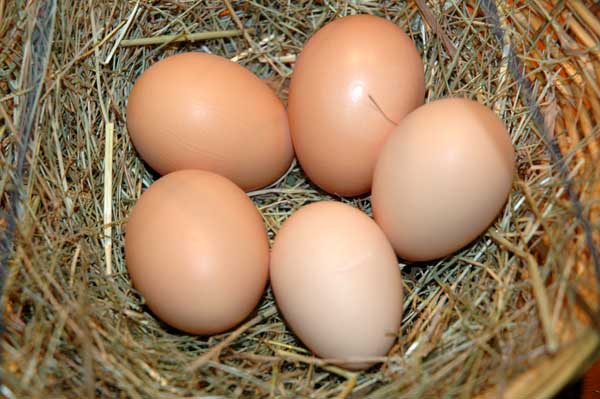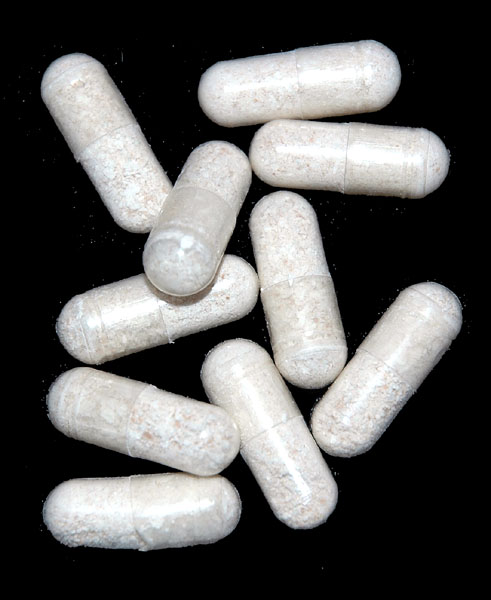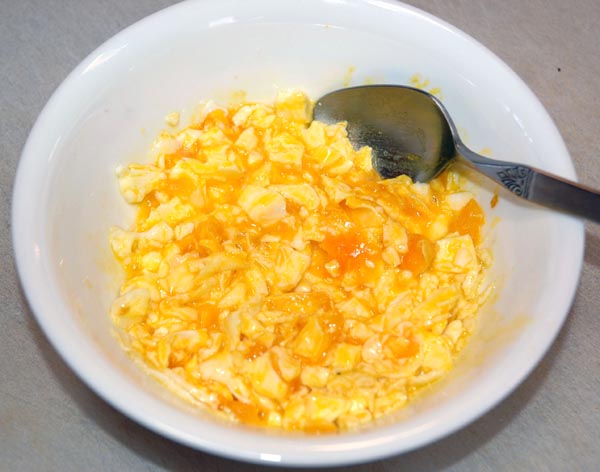Eggs: More Than Just An Empty Shell
By Ginny Chandoha, November 8, 2015
Over the years various food groups have fallen in disfavor, with eggs being vilified for their  cholesterol content.
cholesterol content.
But cholesterol is a complex molecule that is made in, and recycled by the liver. It is a fatty, waxy substance our body needs to line the membranes of every cell, and the sterol in cholesterol is a precursor for the manufacture of steroids.
We also derive cholesterol from our diet, but did you know that there are different size cholesterol molecules or why that makes a difference? It is the small cholesterol molecules found in processed, non-whole foods that clog our arteries, while cholesterol from whole foods such as eggs are large molecule and easily pass through the bloodstream to our liver.
Stress is another cause for an increase in cholesterol production, therefore it makes sense that eggs from happy, organically raised, free range chickens test lower in cholesterol content than those that are factory farmed.
Eggs have been an important whole food since humans first discovered they were edible. Here’s why:
- Eggshell – The shell of an egg is 95% calcium carbonate which is the most bioavailable form of calcium the body needs and can utilize immediately.
- Membrane – The eggshell membrane contains many bioavailable substances that our body needs including:
- Collagen is a fibrous protein important for the strength and elasticity of cartilage and connective tissue
- Elastin gives tissue elastic tension so skin resumes its shape after stretching, and is a protein that is integral for cardiovascular, cartilage and spinal health
- Glycosaminoglycans (GAGs) are vital polysaccarides that are structural components of connective tissue, skeletal structure, and extracellular fluids. Glycosaminoglycans include glucosamine, chondroitin, and hyaluronic acid.
- Transforming Growth Factor-b is a protein that is crucial for immune function and cellular differentiation
- Desmosine and isodesmosine are amino acids that give elastin its elasticity
- Whole Egg – While the yolk is the most nutritious part, one whole egg contains:
- Vitamin D – as much as 41IU
- Calcium – a minimum of 24mg
- Protein – a minimum of 6 grams
- Biotin – a coenzyme known as Vitamin H and is integral in the support of healthy skin, nerves, digestive tract, metabolism, and cells
- Choline – is an essential nutrient for fetal brain development and maintaining brain cell membrane structure in adults, and is a key neuro-transmitter component. It is also a vital element in preventing birth defects
- Lutein – is the most bioavailable source than from any other food group, and is an antioxidant important for eye health and prevention of macular degeneration
- Zeaxanthin – is another eye health antioxidant that works in tandem with lutein
- DHA and AA – Docosahexagenoic Acid (DHA) is an essential Omega-3 fatty acid that supports brain development and cell signaling. Arachidonic Acid (AA) is an Omega-6 fatty acid that supports brain health, and is a precursor to eicosanoids that are important components in immunity, blood clotting, and other vital functions
- Carotenoids – are powerful antioxidants
- Vitamins and Minerals – including Vitamins A, E, K, B12, B-complex, as well as trace minerals of Magnesium, Iron, Phosphorus, Potassium, Zinc, Manganese, and Selenium
How to Eat an Entire Egg
I used to eat and use my store-bought eggs over easy, scrambled, hard boiled, and raw, and throw away the shell. Now I consume every part of an organic egg. Let’s start with the outside and work our way in.
- The Shell – After emptying the contents, I thoroughly rinse the eggshell in hot water and use my finger to rub the interior until left over egg white is rinsed away (the interior no longer feels slimey). This will help reduce excessive foaming when the eggshells are boiled. Do not use any type of soap or detergent as the shell is porous and can absorb unwanted ingredients (note that store-bought eggs are always chemically pre-washed), place in a pot of cold water, cover and bring to a boil, then turn off heat and allow to cool. When cool, thoroughly rinse the boiled eggshells and air dry for 24 hours. I store the dried eggshells in a stainless steel container that I keep on my counter, and to add to it I manually crush down the shells until my container is full. Next I put the semi-crushed eggshells in a grain mill (a coffee or herb grinder also work) and grind until the shells are reduced to a fine powdery grit that I store in a glass jar. While this powder consists of pure calcium bicarbonate and membrane nutrients and can be added to smoothies or other foods, it is too gritty for my taste.
 Instead, using a manual capsule making machine and empty vegetarian capsules, I make my own calcium supplements for pennies. How many pennies? I used to purchase organic raw calcium supplements at a cost of $40 per bottle of 150 capsules and would need 5 bottles per year for a total of $200. Now I buy vegetarian capsules at wholesale price, and 750 calcium capsules using my own eggshells costs a total of $8.60 per year.I also coarse grind the eggshells and feed them to my chickens as part of their daily calcium supplement.
Instead, using a manual capsule making machine and empty vegetarian capsules, I make my own calcium supplements for pennies. How many pennies? I used to purchase organic raw calcium supplements at a cost of $40 per bottle of 150 capsules and would need 5 bottles per year for a total of $200. Now I buy vegetarian capsules at wholesale price, and 750 calcium capsules using my own eggshells costs a total of $8.60 per year.I also coarse grind the eggshells and feed them to my chickens as part of their daily calcium supplement. - The Membrane – When making an organic fruit shake, I peel the raw membrane out of the shell and blend it in the shake. Otherwise, as part of boiled shells it is ground up and becomes part of my daily calcium supplement.
- The Egg White – I used to think I was eating healthy by putting an entire raw egg in my fruit shake. That was until I learned about Avidin. Raw egg whites contain the antimicrobial protein avidin that binds with biotin in the yolk, preventing biotin from being absorbed into the body. Cooking the egg white frees biotin by neutralizing avidin. Now when consuming raw egg, I separate the white from the yolk and use the raw white for other cooking uses.
 The Egg Yolk – Raw egg yolk contains fragile essential Omega-3 and Omega-6 fatty acids, as well as healthy large molecule cholesterol. Cooking the yolk not only destroys the omega fatty acids, but it also oxidizes the cholesterol, turning it into an unhealthy, artery clogging small molecule. Now when I cook whole organic eggs, to get the maximum nutritional benefit I make sure the white is fully opaque, but the yolk is still runny.
The Egg Yolk – Raw egg yolk contains fragile essential Omega-3 and Omega-6 fatty acids, as well as healthy large molecule cholesterol. Cooking the yolk not only destroys the omega fatty acids, but it also oxidizes the cholesterol, turning it into an unhealthy, artery clogging small molecule. Now when I cook whole organic eggs, to get the maximum nutritional benefit I make sure the white is fully opaque, but the yolk is still runny.
The Egg Myth – Many people make the assumption that chickens and their eggs naturally contain salmonella, but that bacterium is not normally present. Salmonella has to be introduced into the environment either from contaminated garments, including shoes, tools or machinery used in processing eggs, or it can arise from filthy factory farming conditions under which most store-bought eggs are raised, and which have been involved in massive salmonella-tainted egg recalls. Chickens raised and pastured in a clean environment do not typically carry salmonella. Plus the egg shell is coated with “bloom,” a clear liquid that dries almost instantly when the egg is laid that protects bacteria from entering the porous shell and contaminating the egg contents. Water destroys the bloom and will allow bacteria to immediately penetrate the eggshell. We never wash our eggs and most of the time they are perfect. Occasionally we’ll get one with a tiny bit of soil on it that I rub off as much as possible immediately, but I still don’t wash them, not even before cracking them open, and we’ve never gotten sick from eating eggs from pastured chickens.
